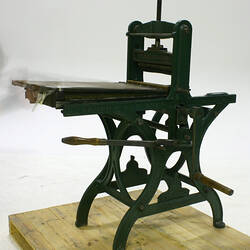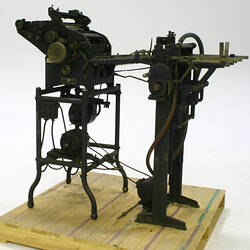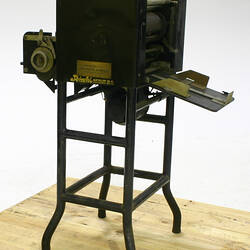Explanation of Lithography
Lithography (Greek, lithos, "stone"; graphein, "to write"), process of printing developed in 1798 by the German, Aloys Senefelder
Lithography involves a flat, lightweight, planographic surface on which the printing area is not higher than the non-printing area; it depends for its action on the mutual repulsion of grease and water. Senefelder found that if a drawing were made on a flat piece of limestone with a greasy crayon, the lines would attract and hold an oily or greasy ink when the stone was wet, whereas other portions of the stone would take no ink. The drawing could then be reproduced on a piece of suitable paper rolled into contact with the stone.
Among prints and printmaking methods in the 19th century, lithography became the chief means of reproducing works of art and illustrating books and magazines.
When the photographic preparation of printing plates was introduced, photolithography came into existence, as did offset lithography, when an extra rubber cylinder was used. They are both now generally considered offset printing techniques. The rubber transfer cylinder runs in contact with the printing-plate cylinder, which has replaced the flat stone, and receives the inked image from it; this image is then offset on to the paper. The rubber cylinder keeps the delicate printing plate from coming in contact with the printed object. Very long printing runs, or periods when the plates are not changed, are thereby made possible, and the faithfulness of reproduction and sensitive shading, unique to lithography, are preserved.
Lithography compared to other methods
Litho printing also known as lithography or lithographic printing or planography or planographic printing. It works on the basic principle that oil and water do not mix. Unlike relief printing and intaglio where the image and non-image areas are at different levels, in lithography there is only one surface.
In intaglio and relief printing the image areas to be printed are raised and the non-images areas form the base surface, which is lower than the image areas. However, in lithography the printing surface is flat.
In lithography a flat stone is treated in a manner so that the image areas attract the oil-based inks and the non-image wet areas repel the oil-based inks. When the stone is pressed against the surface to be printed on, the oily inked image areas leave an imprint of the desired design.
Litho printing is one of the few printing processes that are used both as an art form and commercially. The litho printing process simple and consequently is very popular with art students. Commercially, litho printing or litho is often used synonymously with offset printing. Lithography is the most recent on all the major printing processes.
Litho printing has many applications today. Most artists use lithography to express their creativity in a variety of forms. Commercially, litho printing has come a long way and stones have been replaced by metal plates. The basic printing process remains the same but has been upgraded with the latest technology
http://www.whatislithoprinting.com/ - accessed 14 January 2009
More Information
-
Keywords
-
Authors
-
Article types



